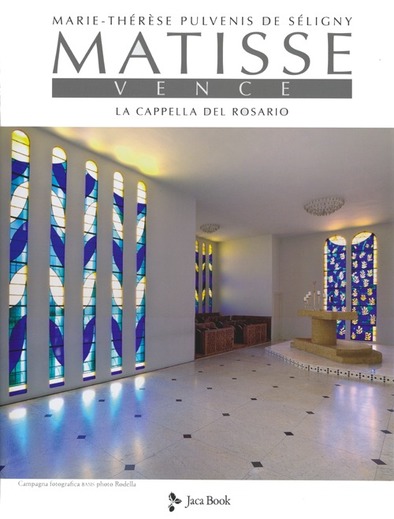MATISSE. VENCE
The chapel of the Rosary
- Category: Architecture
- Author/Editor: Marie-Thérèse Pulvenis de Séligny
- Format: Illustrated/Hardback
- Dimension: 24 cms x 32,5 cms
- Pages: 224
- Price: 90 €
- Year: 2013
- Rights Sold: English, French
- Signs:
Review
The Chapel of the Rosary in the convent of the Dominican nuns in Vence, in the southern of France, is an “all-round” masterpiece of a great master of the XX century: Henry Matisse. After decades of extraordinary painting this was for Matisse “the work”, since himself conceived it as “my work”. Extremely colourful stained-glass windows for a space of light; big compositions made of white tiles with figures drawn on them just by the black trace of a paintbrush; altar furnishings and chasubles for the different periods. We are standing in front of a masterpiece of contemporary art and at the same time of sacred art. All starts when Matisse accepts the invitation of nun Jacques Marie, his previous nurse and model, with whom he will have an extraordinary friendship in his old age from the ’40. The Dominicans with Father Couturier and the journal “Art Sacré” are in the forefront of a religious art entrusted to great artists; Matisse goes beyond his commissioners’ imaginings and gains the help of his friend the architect Perret. In his enormous atelier with the aid of the famous papiers gouachés découpés (colour paper cut-outs) he builds the entire chapel with paper. This technique, or to be more precise, this artistic genre will be fundamental in particular for the stained-glass windows. The unity of this work overcomes the generous fragmentary nature of the coeval church of Plateau d’Assis, where worked the major artists of that time. This volume benefits from a day and night photographic campaign by Studio Rodella, which enables to follow light’s chromatic transformations as envisaged by Matisse himself. The photograms’ electronic junction allows to see the light in the interior and the full tone of colours of the stained-glass windows. Marie-Therèse Pulvenis de Seligny through her text leads us in the genesis and the following development of a work that, although being an ensemble of many different works of art, is conceived by Matisse as a whole: from the confessional to the Way of the Cross (on a single wall, creating an extraordinary visual journey) to the double space for nuns and congregation, to the vestments which are an exultation of forms and colours. The Chapel grows alongside Matisse and develops as a vital body for a spiritual experience. In the history of art this will always be a masterpiece which enlightens contemporaneity.




 Read Description
Read Description